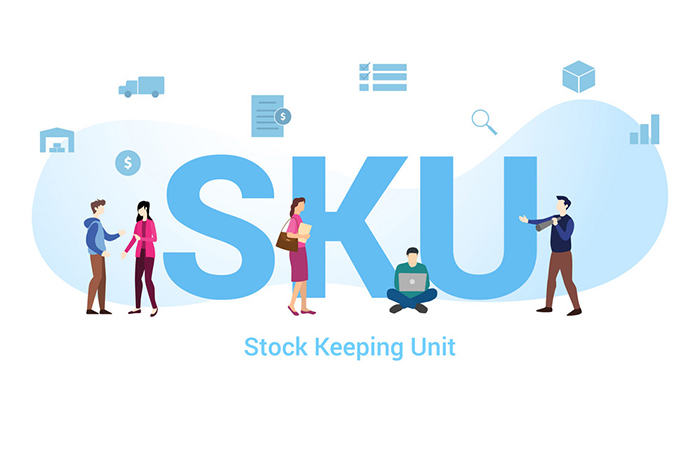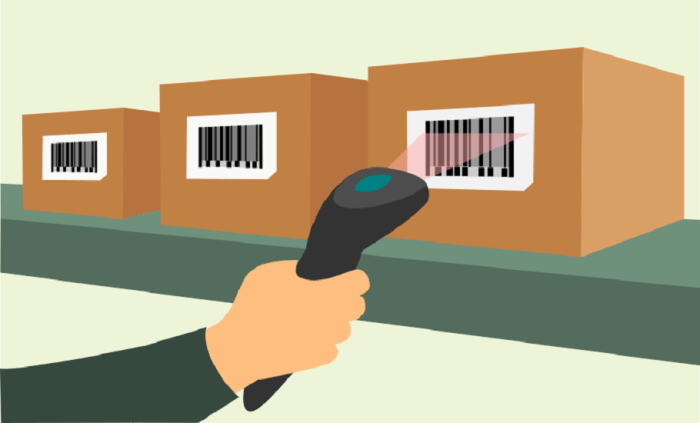Are you an experienced retailer or looking to open your first startup? Would you keep a large inventory of several items or keep the inventory low and specialize in just one? Would you have a physical or online marketplace?
Whatever the answer, you most likely have an SKU architecture in place — or are looking to incorporate one. An SKU assists in the tracking of a particular product. Therefore, a person responsible for running an online store should never assume the establishment is too new or does not carry enough inventory to justify using SKUs.
So whether you are new to retail or you have been managing inventories and product catalogs for a long time, you will already be familiar with this code. Yet you may be unaware of how things work behind the scenes. So, first and foremost, what is an SKU and what exactly does it do?
What Is an SKU?
An SKU, or Stock Keeping Unit, is a unique number that is used to manage a company's inventory internally. SKUs are alphanumeric and should provide details about the most important aspects of a product, such as prices, color, type, brand, gender, style, and size. This material in the SKUs should also be ordered from most important to least important — or, in other words, from most needed information to the least needed.
SKUs are therefore not generally applicable. They are intended to be exclusive to your company and can be customized to represent the most often asked questions from shoppers or vendors about your store's merchandise.

Please take a look at some of the various IDs associated with products, which is NOT an SKU:
- A Universal Product Code (UPC): is a 12-digit universal identifier that represents product and manufacturing details. This is the barcode that you scan in warehouses, at points of sale, etc
- The Manufacturer Product Number (MPN): is the manufacturer's code assigned to each particular product. Including the MPN in your SKU would allow you to easily expose your supply chain
- Barcode: is the combination of UPC and EAN
- The European Article Number (EAN), also known as International Article Number: is a global identifier, including 13 digits. EAN aids in the identification of a particular retail product category, in a specific packaging configuration, from a specific manufacturer. It is often used in combination with the UPC and both exist as a barcode and alphanumerically
How Are SKUs Used?
SKU is a vital piece of knowledge for any product, serving as the manufacturer's secret language and facilitating clear and accurate identification across the supply chain, inventory tracking, and sales.
Now, we'll go over the numerous advantages of SKU to the operation of any company.
#1 Inventory Tracking
When thousands of goods arrive at stores from the warehouse, it becomes almost impossible to track inventory without making mistakes. SKUs promote accurate stock-taking and avoid almost all of the problems involved with warehouse logistics when they use an alphanumeric system that is mostly designed for internal management.
Store owners can get detailed pictures of the product's status and then decide what's available to sell by doing stock counts with SKU's help, which contributes to stockout prevention.
Furthermore, by observing the status of SKUs, the store owner may change and handle items that are in high demand or that are subject to demand versatility.
#2 Significantly Decrease Stock Takes and Shrinkage
Stocktakes should be conducted on a routine basis to ensure that the actual stock level at the factory matches the ones reported in the inventory management system. When each variation of your product is coded with a special SKU, the organization and identification of items using SKUs make stock level reconciliation easy and simple.
Shrinkage is one of the key factors that must be identified, in addition to stock level identification. Shrinkage occurs as products are damaged or lost in the supply chain, which is mostly the result of the burglary. Using SKU, store administrators will maintain the transparency of stock movements and recognize when and how stock goes missing, substantially reducing the possibility of theft.
#3 Forecasting Sales and Reinforce Catalog
You can more accurately calculate the diameter and progression of demand and revenue over time by using a company-specific barcode for each item before making any sales or marketing decisions.
The cost and revenue associated with each SKU number, including scale, colors, materials, etc, would enable you to easily identify which items are your best sellers and which are underperforming. Based on SKU trends, you can get a comprehensive view of your profit stream and then build both long-term and short-term sales strategies to sustainably grow your company.

#4 Advancements in Customer Support
Thanks to the SKU, customer service representatives or salespeople may easily find each product and query. They can find a product, repeat a previous order, recommend related products, or compare product features in a matter of seconds.
For example, by looking at the SKU, the salesperson will determine the product the customer is looking for, analyze the current stock level, and provide different options if the requested product is out of stock.
How to Create an SKU?
Preparation
Before you begin creating SKU numbers for your products, you should first set some ground rules.
First and foremost, what do you want to track? There are no wrong answers, but you can try to choose details that are consistent with all products offered by your company. Your SKU system should be standardized for all of your brands, so don't attempt to monitor each item's wind resistance rating (for example) if that product information only applies to a limited proportion of the goods in your catalog.
In SKUs, the following are some of the most widely tracked product details:
- Size
- Style
- Color
- Material
- Brand
- Manufacturer
- Price
- Product type
General tips
Things that need to be avoided: although there are no incorrect ways on how to build your SKUs, there are a few things to avoid.
DONT: Creating your SKUs with excessive length
Any inventory tracking tools cannot tolerate long product numbers. Get the SKU designs as short as possible.
DONT: Using numbers that resemble letters (and vice versa)
You'll be glad if you just have to enter a code by hand. It can be difficult to tell 1s from I's.
DONT: Being overly general
If you sell two different types of purple T-shirts from the same retailer or brand, you may need to be creative with the codes to avoid duplicate SKUs.
DONT: Do not use space
While each code in your SKU should be separated to make it easier to read, never split up your SKU with spaces for the following reasons. For starters, it can result in SKU plaguing because a person is unsure whether different sets of numbers belong to the same string or SKU. Second, some software can understand space since a hard stop will overlook data following space. Use a dash between each code in your own SKU to solve the space problem, particularly when creating and entering SKUs manually.

Things that need to be considered doing: besides that, we would like to suggest you following best practices in order to build an effective SKU architecture for your business:
DO: Use SKU generator
Although it may be easy for small companies to manually produce SKUs, manual production is not scalable for enterprise brands with an ever-expanding catalog. However, whether you intend to use SKU apps or a third-party free SKU generator, the whole process can be streamlined.
DO: Generate a coding system
The coding system is regarded as an essential part of SKU generation. Even though they have unique SKUs, randomly generated numbers can make SKU management very difficult when analyzing data or adding SKUs to variations within a given product range.
Setting up a coding system of abbreviations is widely recommended for management convenience.
DO: Have a standardized format
You can use a standard format regardless of how you build your SKUs, whether by a generator or by hand. Once you've developed a standard format, always similarly build SKUs. When matching an SKU to an item for picking and delivering, the staff will know exactly what each code represents.
The best strategy is to start with the most important product details and work your way down to product variants. Options with more variations should be put at the top, while those with fewer options (such as gender) should be placed at the beginning, but usually after the product category and product type.
Here's an example of a format you should use with your SKU system: Gender > Material > Size > Color > Brand > Product Category > Product Type > Gender > Material > Size > Color
In case you must include a great deal of information in your SKU formats, try to create SKU codes that are no more than 3 characters long or use numbers rather than multiple characters.
SKU Inventory Tracking in eCommerce
You can track your SKUs to optimize your inventory and boost income. Setting reorder points for each item is the easiest way to use SKUs, which ensures that you can only order stock as needed, avoiding stock-outs while still saving money and other resources.
If you are an eCommerce store owner, it can be extremely beneficial to use the same SKU system on the store as you do for inventory management. Especially if you use inventory management software to connect the two rather than spreadsheets, as this ensures that the inventory is still up to date across all systems and that you can deliver to your customers on time.
However, keep in mind that not every retailer would be tracking the same thing, so it's important that you analyze your company's specific needs before designing your SKU architecture. These are 4 steps for you to take off:
Step 1: Consider the stock’s size
If you want to keep things minimal, you might design an architecture that tracks customer age groups, such as adults, adolescents, kids, and so on. If your stock is on the larger side, you will want to continue breaking down the product's characteristics after the customer age group to include additional product information, for example - age > gender > size
Step 2: Make sure the number sequence is unique
If your SKUs are identical to a manufacturer's SKU or were duplicated with various items, you may be unable to accurately manage your inventory. Here are a few things to keep in mind when creating your naming pattern:
- Keep your character count between 8 and 12 chars
- Begin the number with a letter if possible
- Never use zero
- Maintain an easy-to-understand format
- Be certain that each letter and number has a meaning
Step 3: Keep the customer in mind at all time
You should also take into account what is important to your customer about your product. Do your customers always inquire about color? If this is the case, you should keep the color number at the beginning of your SKU so you can easily supply your customers with the details they need.
Step 4: Choose your inventory system
Most point-of-sale systems would encourage you to create an SKU architecture within them. If you don't have one and have a small inventory, you can build it by hand on an as-needed basis. You may also use an online generator, such as Primaseller or TradeGecko, to assist you with the process.
Conclusion
That's all of it! What you need to know about SKU management and implementation.
We can easily see that SKU is an essential part of your company's operations. Before making any sales decisions, proper SKU organization will undoubtedly help your sales and provide you with more insight into the business operations.
By following our recommended practices, you can build your own SKU code while avoiding some common pitfalls. Manual SKU generation is appropriate for small businesses; however you must analyze, we also recommend using SKU generators for quick and accurate performance for larger businesses.
We hope you now have enough resources and experience to set up our own SKU system. Thank you for taking the time to read this “what is an SKU" article. If you have some more requests for us, please send them here.
















